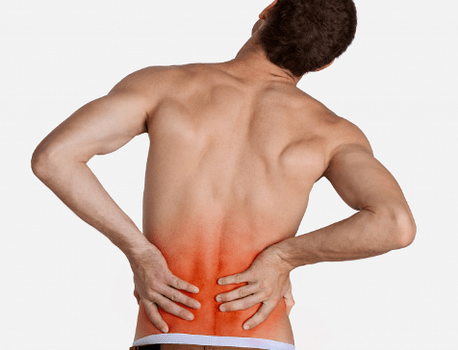Lumbar osteochondrosis is a deformation of the spine in the lumbar region.The disease affects intervertebral discs, cartilage tissues, spinal roots and nerve fibers and causes back pain.
Reasons

The main cause of the disease is the improper distribution of the load on the musculoskeletal system.Usually this happens when walking in high heels, wearing a bag on one side, with an uncomfortable pose in a dream or at a sitting work.At risk are elderly people, pregnant, only born, professional athletes and office workers.
Other causes of lumbar osteochondrosis:
- injuries, bruises, fractures of arms, legs, spine;
- damage to the organs of the musculoskeletal system;
- gastrointestinal diseases that provoke a deficiency of beneficial substances;
- body tension at prolonged loads;
- psychoemotional disorders;
- violations of blood flow in the spinal column;
- inflammation of the musculoskeletal apparatus;
- infections of internal organs and vertebrae;
- stiffness of the joints, displacement of discs;
- protrusion and intervertebral hernias;
- severe intoxication;
- metabolic disorders;
- curvature of posture;
- sedentary lifestyle;
- dehydration;
- unbalanced diet;
- Calcium and oxygen deficiency;
- Excess weight;
- bad habits;
- age -related changes;
- joint diseases.
Symptoms of lumbar osteochondrosis
The intensity and nature of symptoms depends on the stage of the disease.The faster the patient finds signs of lumbosacral osteochondrosis, the more effective the treatment will be.
General symptoms:
- severe pain at the bottom of the back, which can give to the feet, internal organs of the abdomen and pelvis;
- pain in the kidney and sacrum;
- fatigue and stress in the lower back and sacral section of the spine;
- difficulties in moving, walking, inclinations and turns of the body;
- Periodic background in the back;
- fatigue after minor load;
- crunch in the back, violation of mobility, pain in a calm state;
- numbness of the limbs;
- spasms and cramps in the muscles;
- dizziness;
- weakness and loss of strength;
- Reducing muscle tone and sensitivity.
In men and women, manifestations of lumbar osteochondrosis may vary.Men may have problems with potency.Women often suffer from pain in the pelvis.When a deformed spine cannot fully support the back, the uterus and appendages experience additional loads, and sometimes move about a normal physiological position.
Varieties
The classification of osteochondrosis of the lumbar spine consists of several varieties of the disease.By the type of pain syndrome, they distinguish:
Lumbago.Acute symptom.It is expressed by sharp bastards and the inability to move.It occurs with muscle cramps, injuries, pinches of discs and nerve roots.
Lumbalgia.It is characterized by long-term aching pain caused by hernias, protrusions, spondylarthrosses, ligaments and other disorders of the musculoskeletal system.
Sciatica.Powerful pain syndrome in the lumbosacral department, Eradiri in the basin.The pain applies to the sciatic nerve, prevents the normal bending and extension of the body, prevents me from sitting and standing painlessly.
Discogenic lumbar osteochondrosis and Radiculopathy are also distinguished.
Discogenic lumbar osteochondrosisIt is accompanied by a loss of sensitivity and numbness not only of the sore back, but also the legs, buttocks, the hips and the bottom of the abdomen.Sometimes body temperature rises, weakness, urinary incontinence, the patient loses weight.
Radiculopathyexpressed by numbness of nerve roots and a decrease in human motor abilities.Signs - tingling or soreness of the entire lower body, impaired reflexes, decrease in muscle tone and joints of the limbs.
Stages of development of lumbar osteochondrosis
Doctors trace the dynamics of pathology in four stages:
- First.Symptoms are almost invisible - they are diagnosed in an X -ray.The stage begins with pathological processes in the Purposly cavity of the overdred disk and microcracks of the fibrous ring.
- The second.The height of the intervertebral discs is reduced, which makes the vertebrae closely located.This causes the sliding and displacement of the vertebrae, which is accompanied by pain during movements.
- The third.It is characterized by stiffness, instability, numbness of the body in the coccyx, lower back and sacrum.This can be explained by the protruding vertebrae, proprusions, joint dislocations and arthrosis in the spine.
- Fourth.The most severe degree.The functions of the spinal column are impaired on it and bone growths (osteophytes) are formed.Growals can pinch nerves or damage the integrity of the vertebrae.
The consequences of osteochondrosis of the lumbar
- Excessive accumulation of salt in the body;
- development of hernia, protrusion, prolapse of the vertebrae and discs;
- chronic radiculitis;
- Paresis and paralysis of the legs.
Diagnostics
The lumbar osteochondrosis and other disorders of the musculoskeletal system can diagnose orthopedist, osteopath, neurologist, rheumatologist, manual therapist and surgeon.It is possible to make an accurate diagnosis after:
- X -ray of the spinal column, which shows the condition of bone, cartilage and muscle tissues, as well as ligaments and tendons.
- Myelography - studies of cerebrospinal fluid with dye.With its help, the nerve roots of the spinal cord are studied and evaluated.
For a more detailed examination, doctors use CT and MRI.You can undergo diagnostics in the clinic.

























